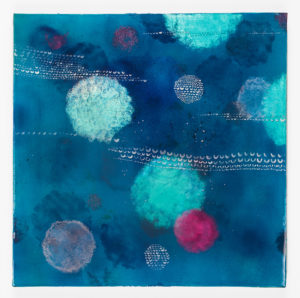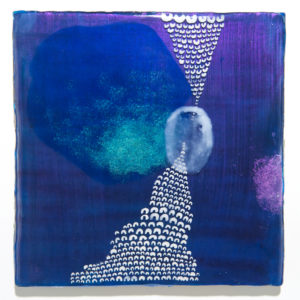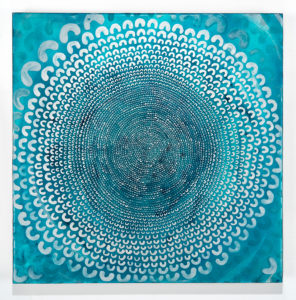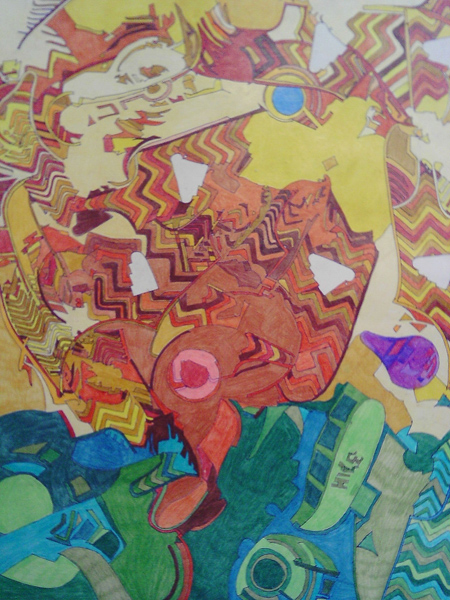What’s So Great About Perfect?
Just what exactly is “perfect” and where do we formulate our notion of “perfection”?
I believe that perfectionism is the root of many an artist’s block.
I’ll never be good enough.
If I can’t do it as well as ____________, why try?
I’m not sure my idea is worthwhile.
What if I fail?
My project could never reach the beauty and perfection of the idea in my head.
We often talk ourselves out of doing something before we even get the chance to start.
I am reminded of something painter Agnes Martin once said:
“We cannot make anything perfectly but with inner contemplation of perfection, we can suggest it.”
I made this video because I’d like to invite you to pick up the reins of a project or piece that is waiting in the wings for the perfect time, the perfect place, materials, amount of money, the perfection of your skills, or whatever notion of perfection is preventing you from diving in.
See what happens.
And let us know, OK?
Leave a Comment
Art & Meditation: Transforming Barriers to Creativity

In my last blog post, I introduced you to the idea of including meditation into your daily life as a way to begin tackling those negative internal voices that so often cripple us as artists. I know that a lot of people may be skeptical of how helpful a meditation practice can be, but the benefits of becoming more aware can only serve to help us grow as artists.
A couple of years into my meditation practice, when I was still struggling in the studio with insecurities and self-criticism, I remember a big breakthrough. I was working on a very large painting. It was my largest painting to date and I had invested a lot of time and money making it. But the piece felt flat and unpainterly to me.
I remember one day looking at it and it felt totally unsolvable. I just hated the piece. And I couldn’t think of how to solve it. I was feeling frustrated and discouraged and because I had spent so much on the materials, the thought of abandoning it didn’t seem a viable option. For some reason that day, I had the presence of mind to just stop and sit with it. Not try to think it through or solve it, just be present with it, as I would in meditation. And in that silence, I got an idea for something to try. Since it was about the worst painting I had ever made, I had nothing to lose. When I tried my new idea, I was completely delighted with the results and full of exhilaration and fresh energy for the piece. I broke through what I call “the Wall.”

“The Wall” seems to happen over and over in creative work. It’s when you are at an impasse. You’ve already invested quite a bit into the project. So it definitely feels like more is at stake. It can feel like there’s no way out, no solution.
Sometimes the best way through is to do “nothing.” By nothing I mean to empty oneself and become receptive. Meditation can teach us how to do that.
A daily practice of meditation teaches us to discern between mind chatter and our inner wisdom. It’s easy to get caught up in our thoughts, circling over and over with various possibilities and choices without gaining clarity. Without awareness, our thoughts drive us. Having your thoughts driving you is like being dragged around behind a wild unruly stallion. I am inviting you to learn how to get back in the saddle, and guide your mind by developing a respectful, cooperative relationship with it. When we can get some distance between our self and our thoughts, we can choose our thoughts.
What is remarkable is that when we shine the light of awareness on a problem without identifying with it, this problem tends to become less daunting. In our calm awareness, insights and solutions naturally arise. We may be inspired to action, but without the sense of willfulness and effort we may have formerly applied to similar situations. For example, in the past when I was frustrated with a painting, I might have pushed on through, painting over and over it even though I knew it wasn’t going well and I wasn’t enjoying it. I would apply my willfulness and work ethic, hoping for some kind of resolution. And sometimes that approach does work. But these days, when I am at an impasse, I am more likely to stop, sit quietly, close my eyes and go inward, allowing ideas to enter my head. It never takes long, and the most unexpected and delightful solutions present themselves.
What do you do to break through blocks and barriers to creativity or move past what I call “the Wall” in your own practice? I invite you share your thoughts in the comments below.
Leave a Comment
Meditation and the Studio: Becoming Aware
It may surprise you to learn that I wasn’t a star pupil in art school. Not one of those students who carried those black, hard-backed sketchbooks everywhere, bursting with sketches, paintings and collages. Not the kind of art student who spent every waking hour making things. I was a diligent, attentive student. I did the assigned work, attended every class and loved it all. But when I started, I hadn’t the first clue how to turn out original work.

After graduation, I went through a difficult period in my creative life. I knew I wanted to devote my life to making art. But crushing self-doubts and critical voices plagued me every time I tried to work in the studio. I showed up to the studio regularly and managed to get work done, but I suffered from inexplicable fatigue due to the inner emotional stress of these critical voices. I sometimes grew distracted and unfocused. I sought out self-help books and groups for creative people, and slowly and subtly things began to change.
In my work as a teacher and artist for over thirty years, I know of many artists can relate to this feeling of paralysis or being stuck. For me, turning to mindfulness and meditation helped me make that shift to becoming the artist I am today. A lot of people believe that meditation or mindfulness is about reaching some exalted state, but it is actually about learning to be present.
When we practice meditation we naturally become more aware. Aware of our thoughts, our unconscious habits, the feelings and thoughts of the people around us, our impact on others. And the longer we practice, the more we notice. We notice subtle things that were always there – we just couldn’t see them before. Sort of like someone whose fuzzy vision becomes clearer with a new pair of glasses.

This type of deep noticing can have a profound impact on our creative work. As Paul Valéry put it: “To see is to forget the name of what one is seeing.” By being fully present with what we are creating, we can move beyond preconceptions and habits and encounter the work afresh.
If you’ve never spent time meditating before, you may find your mind to be a very messy place. Most of us have habits and patterns of thought that we unwittingly developed in our youth by simply imitating the patterns of thought of those around us. Patterned thoughts become like grooves in our brain – neural pathways – that can create habits of self-criticism, fear, doubt, cynicism, pessimism or worry. We scarcely notice them because they are so ingrained in us. And if we don’t notice them, we can hardly be aware that it is those habits or patterns of thought that are driving the circumstances around us.
If you are new to meditation, here are a few simple steps to experiment with it:
- Set aside 5 minutes each morning. As early as possible upon arising is easiest because your mind is still fresh and you don’t have as much resistance to the idea. (I’m too busy, I don’t feel like it, it’s too hard.)
- Find a comfortable and pleasant place to sit. One where you can sit in the exact spot every day.
- And if you have a smartphone, I suggest setting a timer with a gentle ring so your mind doesn’t need to be preoccupied with how long five minutes exactly is.
- Settle in: Ensure that your posture us upright, your chin ever so slightly turned down to elongate the back of your neck. Allow your shoulders to be comfortably loose and relaxed, with your shoulder blades on the same plan as your spine, rather than hunched forward.
- Gently close your eyes and just notice that breath. Pay attention as it fills your lungs quite easily and naturally, and then as it is expelled just as easily through your nostrils.
Thoughts will arise. About whether you remembered to take out the garbage last night, or the first appointment of the day, or that annoying thing your co-worker said yesterday. But you are not going to engage with those thoughts just now. You are going to notice the warmth of the breath as it gently flows in and out. And how your jaw has naturally unclenched and how every muscle is gently melting, releasing habitual tension. And the thoughts may come back: How long has it been now? Surely five minutes is up. I can’t sit here doing nothing! I have so much to do today! And then like a little child who has wandered off, you will gently take your mind by the hand and lead it back to the present moment.
If it helps, you can count your breaths. But just stay with the breath. And without noticing it, you have actually drifted into deep connection. You are not thinking. Then you notice that you are not thinking, and now you are thinking again. And so, you go back to your breath. Such is the task of a meditator. Like trying to take a knot out of a tiny thread with a needle. But hang with it. Please. It gets easier. Because you will untangle that knot and then that tiny thread will stretch out before you free of its knots. Before you know it, there is no thread at all.
Do you currently practice meditation in your daily life? Share your experiences in the comments below!
Leave a Comment
Art is about “We,” not “Me.”
Do you ever feel hesistant or uncomfortable about sharing your work in a public forum? Here’s a possible reason why – you don’t want to attract attention to yourself. Here’s how to take your “Self” entirely out of the equation.
In this vision, I really FELT myself and my work as belonging to the community. Can you close your eyes and imagine this for yourself?
Leave a Comment
Motivation to Create! Six reasons to go make stuff NOW!
We all need a little push now and again. Sometimes we’ve just gotten busy and neglected making art for a little while or maybe we had a job or were raising children and neglected it for a good long while.
Whatever the reasons, here is some inspiration to help get you back to work! If not RIGHT this moment, then hopefully sometime in the very near future!
- Think how good you’ll feel when you do!
- Only by doing it will you be able to move through ‘the wall’ to free creative energy.
- You need creative time to bring out the best in yourself.
- The Butterfly Effect – Your creativity effects other in ways you will never know. You don’t have to be a “famous” artist to have an impact. Just think of how we are still affected by the cave paintings done over 6,000 years ago by anonymous early humans or the baskets, weavings, ceramics, etc. created by people in civilizations who predate ours.
- It’s an antidote to consumerism. Adds to the good in the world.
- Creativity connects you to something greater than yourself.
Now go make something. NOW. Go do it! Even if it’s just for 10 minutes! Yay!!
If you’ve been missing making your art, share below and let us know which reason resonated the most with you?
What are some other reasons you can come up with to do your creative work?
Leave a Comment
What Inspires You?
In this feature, each month artists share one thing that excites them creatively.
One key piece to support healthy, productive creativity is stimulating inputs. What kinds of things stimulate the creative centers of the brain? What kind of inputs stimulate us visually? Emotionally? Spiritually? Mentally? Physically?
I’d really like to know, what’s one thing that fills your creative cup? Share with us in the comment section below.
Matthew Johnson

Hello M.A. bloggers, my name is Matthew Johnson and my creative stimulation dwells within the realm of the creation we call “Life.” From the tiniest insects that stroll around among the vast plains, and rolling hills of this planet, to the human machines that occupy this world, and discover the ins and outs about our existences through experiences. There are so many outlets that my artistic view drives upon, and my mind travels alongside imagination avenue with my solar-battery operated automobile packed full of music, paint, pens, and a broken navigational device (to ensure that I am in no way shape or form ‘set’ within any boundaries of expression). As you stroll through the corridors of the imagination, it is only you that can entail what you see and then begin to proceed to create the pieces you’re driven to produce. Continue all the great work, and may peace be your imagination’s significant other.
Matthew Johnson
Toni Murgas
 Things that inspire me may be a picture of nature, a book I’m reading, a dream or a song. I was reading a book on Edward Manet and how he used to cut paper as he got older to create his art. This inspired me to cut and paste colored paper.
Things that inspire me may be a picture of nature, a book I’m reading, a dream or a song. I was reading a book on Edward Manet and how he used to cut paper as he got older to create his art. This inspired me to cut and paste colored paper.
Toni Murgas
Leave a Comment
